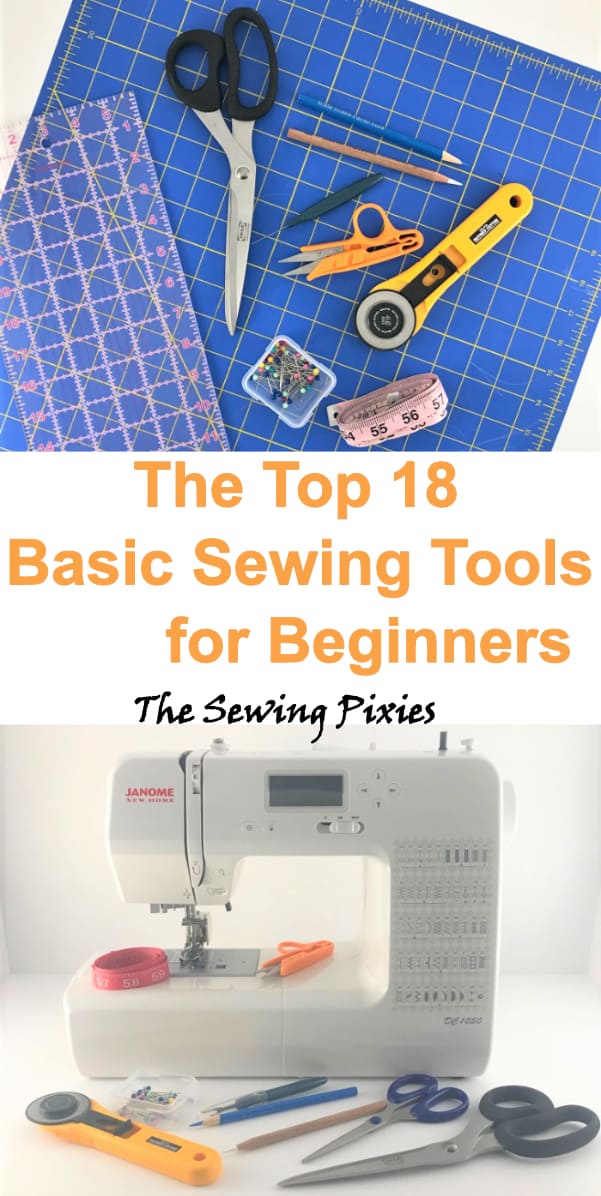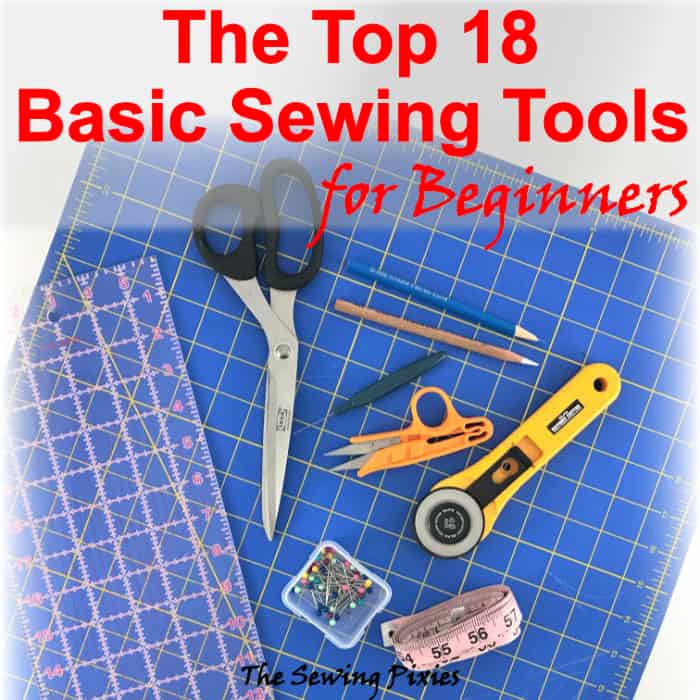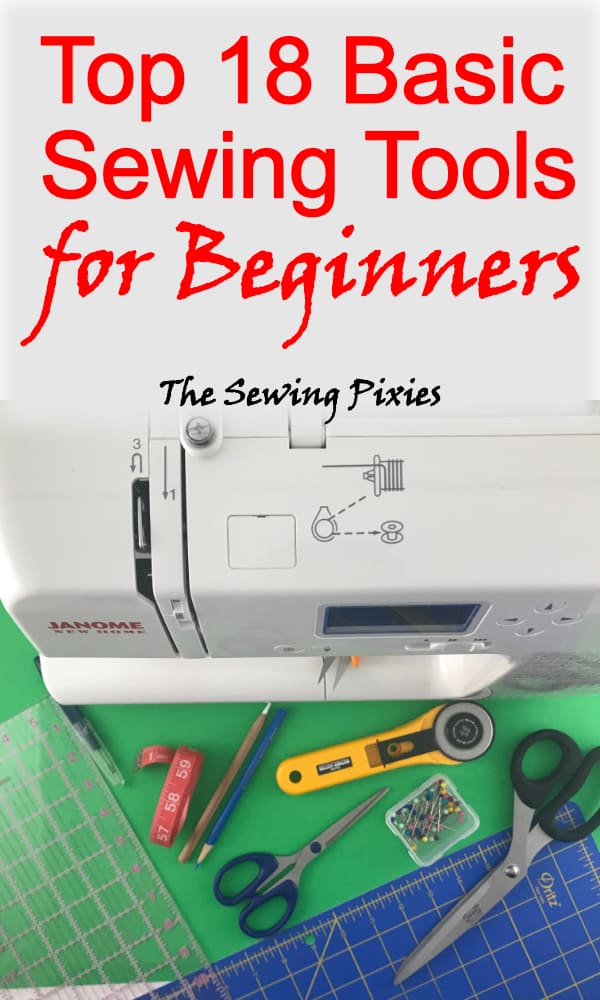Are you ready to start sewing? First, you need basic sewing tools that I tried and highly recommend.
I am sure you are excited to start sewing beautiful projects that you can use as a gift for your loved ones, fun garments for your kids, or some decoration for your home. I will tell you what basic sewing tools you need to start sewing! Do you have any idea what your first sewing project is going to be?
I am excited to share with you the top 18 basic sewing tools you need to get started with sewing.

This post contains some affiliate links for your convenience (which means if you make a purchase after clicking a link I will earn a small commission but it won’t cost you a penny more)! I always recommend products I tried, use, and love.
Sewing machine. You need to have a working machine that you like and feel comfortable using. If you already have some beginner sewing machine that has been hidden in your closet for some time, stick with that one for a while. Those basic machines are fine for learning and sewing basic things. You need a sturdy and more reliable machine if you are planning to sew lots of projects using different fabric thicknesses. That what I was planning, and before I bought my machine I have searched and searched for the one I liked.
Finally, I decided on Janome DC 1050 and I love it! It has superb features that are allowing to sew with cotton as well as stretchy knit fabrics. It easily handles thicker fabrics such as denim and even leather with the proper needles. The best part is that for all the fantastic features it has the price is very reasonable.
Sewing needles. Most sewing machines come with some sewing needles included but believe me you are going to need much more. I recommend stocking up on size 14/90 microtex needles so that you can use a new needle whenever you are starting a new big project. A new needle keeps your stitches looking pretty.
It is good to have some of the 100/16 denim needles that you will use when sewing through thick layers and heavy fabrics.
The other needles that you may want to have on hand are ball-point needles for sewing knits. These needles are designed to glide between the loops of a knit fabric without disturbing the fibers that make up the fabric and either skipping or causing a run.
Presser’s foot. I find that I can get all the sewing accomplished as long as I use the correct needle and presser foot. For most machines, you can buy different presser feet for specialty jobs. Most machines come with the standard presser feet. This is the foot that you use for basic sewing. You can use it for both straight and zigzag stitching and you can get almost all of your sewing done with this foot alone.
I would encourage you to get a walking foot also called even-feed foot because believe me, it will make sewing much easier. A walking foot feeds top and bottom layers of fabric at equal rates, allowing you to more easily match patterns or stitch bulky layers. If you have layers of fabric and batting or thick interfacing, walking foot is a must.
I always use walking foot when sewing with knit fabrics. It doesn’t stretch the fabric out of shape.
Actually, there’s no reason you shouldn’t use walking foot for regular piecing and sewing.
Below are a few reasonably priced walking feet that I found on Amazon.
Sharp pair of scissors that are used just for cutting fabric. A basic pair of good-quality scissors that you have sharpened regularly should last you a long time and do a great job with your fabric. Believe it or not, I found fabric scissors at Ikea, and I love them. They are heavy and perfectly fit into my hand. I hope Ikea will continue selling them for a long time.
Pinking shears are used to finish seam allowance to prevent the fabric from fraying. They cut fabric in a zigzag pattern, which creates fun, decorative cut and also helps in trimming curves.
Snips (small scissors) are handy for cutting and trimming threads, also recommended.
A rotary cutter works like a pizza cutter and can be used by left-handed and right-handed sewers. Make sure you take good care of the blades and replace them when needed. The blades are very sharp so please make it a habit to always retract and lock the blade when not using, even if you are putting them down for a minute.
Cutting tools use only for your sewing! Cutting paper or other household materials will dull your cutting tools quickly. Dull tools can damage the fabric.
Self-healing cutting mat is needed when using a rotary cutter. It protects both the work surface and the blade. Get the biggest cutting mat that you can afford so that you can cut yardage with ease.
Clear ruler and cutting mat work together like a T-square- helpful when marking and cutting perfect 90-degree squares and rectangles. The straight edge and quarter-inch increments on the ruler are helpful when you need to mark even strips of fabric. Also, the fabric is easier to cut when the ruler provides a guide for a rotary cutter to run along.
You may find a lot of clear rulers of different lengths, but I recommend getting one that’s 24” long and 6” wide.
Seam ripper quickly removes stitches, but be careful not to cut the fabric. You want seam ripper to be your friend because even advanced sewers make mistakes 😊. Make ripping out stitches as pleasant as possible, that’s why buy a sharp seam ripper. When your seam ripper gets dull, throw it away and buy another one. You can’t resharpen them.
Measuring tape has the flexibility helpful for measuring items with shape and dimension, that’s why is used for taking your own measurements. I recommend that you use a plastic-coated fabric tape measure. It doesn’t stretch, so you always get accurate measurements.
Many tapes come with both metric and U.S. customary measurements, which is helpful for people that are brought up on metric measurements, like me. I don’t know about you but I’m often confused with converting inches, to feet and to yards. That’s why my brilliant idea is to mark the tape with the conversion 😊.
Pins. I recommend using long, fine, glass-head pins. The glass head fits comfortably in your fingers when you pin through multiple layers of fabric, and the extra length makes pinning more secure.
Use ball-point pins when sewing with stretchy knits to avoid damaging the fabric.
Pincushions provide a safe and handy place to keep your pins. Most pins come packaged in convenient plastic boxes that make great pin holders. I wear a wrist pincushion for convenience and time saving, they stay with me wherever I go.
Hand needles. Buy the variety packs, because they have from five to ten needles of various lengths and thicknesses. Some even have different-sized eyes (the holes that the thread goes through to keep it attached to the needle).
Wash-out pencils. I recommend buying white for marking on dark fabrics and darker (I use blue) for marking on light fabrics. They erase with a drop of cold water.
Ironing board. Make sure you have a padded ironing board because, without the padding, seams and edges press against a hard surface that scars the fabric. Choose muslin or non-reflective ironing board covers.
Iron. Choose an iron that can make steam and has a variety of heat settings to accommodate all fabrics.
Pressing/ironing at each stage of construction is the secret to a perfectly finished garment. The general rule is to press each stitched seam before crossing it with another.
Thread. I recommend Coats & Clark or Gutermann, because they are good quality thread and are reasonably priced. Usually, I have cream, white and black thread on hand.
I hope you enjoyed my post on The Top 18 Basic Sewing Tools For Beginners, and you will have a great time creating beautiful projects.
You can start with Fun Tie Skirt or Mushroom ornament, these are beginner-friendly projects. Also, you can get sewing ideas from books with easy-to-follow patterns and step-by-step instructions.
Happy sewing!
Want To Remember This? Save The Top 18 Basic Sewing Tools To Your Favorite Pinterest Board?


